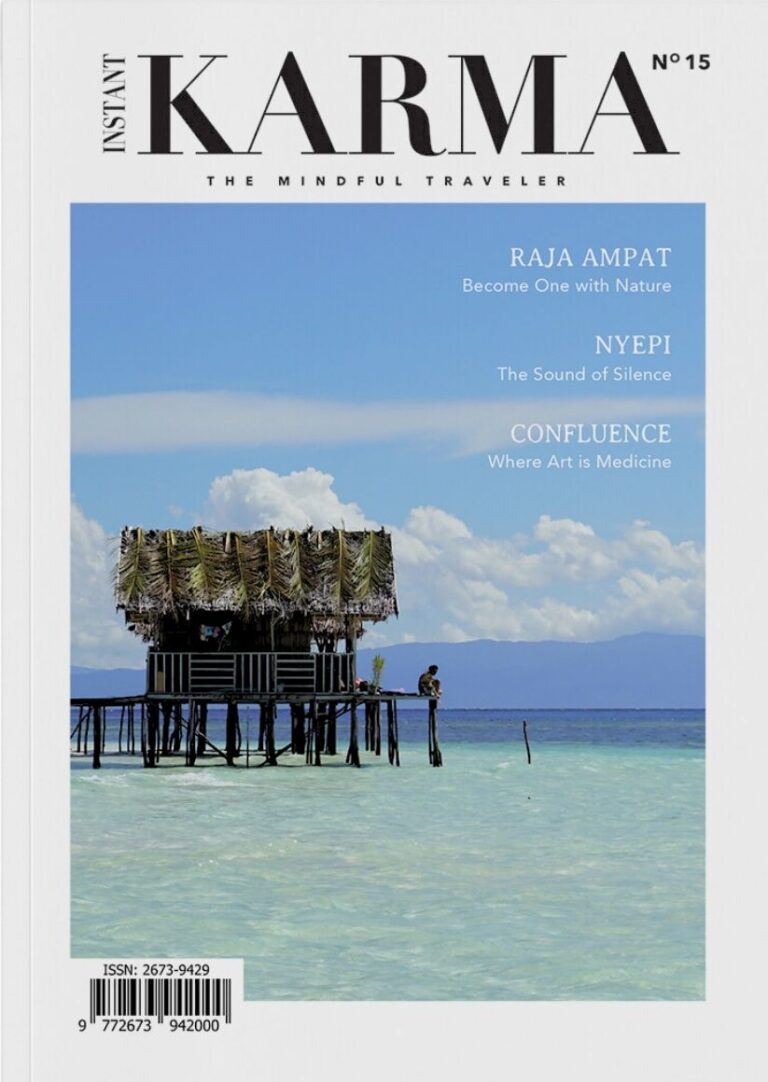There are many ogoh-ogoh artisans in every Banjar in Bali. However, the name Kedux, representing banjar Tainsiat in Denpasar, stands out. He is a multi-hyphenate—he owns a successful customized motorcycle shop, a sculpture company, and a clothing store—but crafting an ogoh-ogoh from scratch will always be part of his life as a Balinese.

His creations have won many awards, but he’s humble and struggles even to remember his winning days (he’s “won third place, second place, and first place”).
These days Kedux acts as more of a mentor to the young people in his Banjar with high hopes that the skills and knowledge they acquire from designing an ogoh-ogoh can lead them to bigger things.
We meet Komang Gede Sentana Putra, aka Kedux, in his motor shop called Kedux Garage to chat about ogoh-ogoh.
What initially drew you to the art of creating the ogoh-ogoh?
In the beginning, I actually never really thought about it because it is a part of Balinese culture that I have been doing since I was little. It’s kind of the same as praying. People would ask, why do you like to pray? And I answered because I have been taught to do it since I was a kid. So, it was more of a cultural process.
Another thing I like about creating ogoh-ogoh is the teamwork.
There are differences in skills and knowledge amongst the team, but the objective is the same: to create ogoh-ogoh. There is always that sense of euphoria associated with it because Hari Raya Nyepi is Bali Hindu’s New Year, and the day before—the pengerupukan— we all get together to show our creativity.

Tell us the thought process in creating the ogoh-ogoh? Do you start with a story or a particular philosophy?
Well, not always. Sometimes I didn’t start with anything in mind as long as we had an ogoh-ogoh in the end. However, sometimes there are stories behind them. The most recent example was during the pandemic.
It was quiet in my home during the two years of the pandemic. My relatives who worked at hotels had now either turned to selling food or were unemployed, and there was a sense of desperation.
I got up the courage to offer the idea to create an ogoh-ogoh to the young people in my Banjar, even though it might not be paraded down the street.
We would consider it mebanten (an act of service) in the Banjar.
Then it unexpectedly grew bigger and young people from other Banjar, and even other regions like Negara and Gianyar also wanted to participate. We asked for the attention of the governor, and we all had the same vision: to revive the economy.

The theme for that year was kipas or kepet in Balinese (fan) because it gives comfort, and we needed that at the time.
There was all this mixed information [during the pandemic] with the lockdown, which made people afraid. We needed certainty, and we needed something that could give us comfort. That was why I chose the kipas as the theme.

Are there any others that stand out?
The year before that—in 2019—the theme was payung or tedung (umbrella). At the time, the economy was good, and work was coming in, but the weather was so unusually hot. I had to do this motorcycle project that would be displayed in Japan, and the heat was just sticking to me.
Then I flew to Kyoto and when I arrived there six hours later from Bali, I was amazed at how different the weather was. It was raining and cold, and people wore kimonos and umbrellas even though it was just a light rain. That contrast made me think of the theme of an umbrella as an object that provides shelter.
We made the usual ogoh-ogoh and the crown was an umbrella, with the hope that it could protect my village because I was afraid that the extreme heat could cause some sort of plague or drought. As it turns out, the following year, covid happened.
Have you ever had an underlying social commentary in your ogoh-ogoh?
As a matter of fact, we designed the kipas-themed ogoh-ogoh to be able to lie down, and that was a critique of the city of Denpasar. The city is billed as a cultural tourist destination, but in reality, it is a bit messy with low-hanging electric cables that make it difficult for something like ogoh-ogoh or other ceremonial objects to pass.
We tend to show only the good in Bali in books or on the internet, but I am afraid people will be disappointed when they see it in real life.

How long does it take to create an ogoh-ogoh, and can you tell us the costs of making them?
It takes about one month or a month and a half maximum with 10 to 20 people onboard. And the cost varies from 50 to 100 million rupiah and that amount we usually get from sponsors.

The creation of ogoh-ogoh is a confluence of different kinds of art forms. What are your thoughts in that regard?
I have this belief that an ogoh-ogoh artist should not just be relegated to that one particular day. My vision is that we should be able to hone our skills deeper and discover what can be developed so that it can be an asset in the future.
After a discussion with the team, I founded another business venture called Wahana Karya Semesta (WKS), which specializes in creating sculptures. With this company, I wanted to gather all my artistic friends throughout Bali, where a routine activity has become part of the culture.
Once they mastered the art of creating a character or philosophy, I have confidence that technologically advanced countries would want to use our human resources.
I hope that in the future, in Bali, the human resources will not only be limited to working on cruise ships or doing the laundry, but they can also become, for example, a robot designer in Japan or a sculptor in a palace project somewhere.
There might not be a school (for creating ogoh-ogoh), but at least there can be a future in it.
What are you most proud of after completing an ogoh-ogoh?
Winning first place is not what I’m most proud of, personally. It’s more about creating a character and a philosophy [behind it], especially when it feels relevant to our living times. Winning people’s hearts is far more important to me.
Also, when I can infuse traditional design.
Sometimes you see a modern ogoh-ogoh in the form of a human wearing a bikini or a cartoon character with club music blasting from the sound system. There is nothing wrong with that, but it’s just not appropriate for ceremonial purposes. I like to see traditional culture represented.
Follow on Instagram @STYSBTAINSIAT




